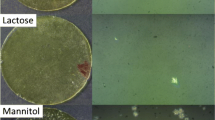Abstract
Dimenhydrinate is a heat-sensitive antihistamine with a low melting point. The heat-sensitive feature is of importance if direct compression is used. Direct measurement of the heat originating in the texture of tablets during compression is very difficult. Thermoanalytical methods were used as indirect methods to describe the changes in material properties at high temperature: differential scanning calorimetry, thermomicroscopy and thermogravimetric analysis. Film coating method is widely used in pharmaceutical technology. A fluidized bed apparatus was applied to coat the crystals. The coating film forming agent was hydroxy-propyl-methylcellulose (HPMC), which is a gastric-soluble polymer. Thermoanalytical measurements reveal that dimenhydrinate crystals are sensitive to heat. Film coating method does not alter the shape of the DSC curve of dimenhydrinate, but increases the melting point. The presence of a macromolecular film reduces the thermal conductivity, because it separates the particles.
Similar content being viewed by others
REFERENCES
P. Ridgway Watt, Tablet Machine Instrumentation in Pharmaceutics: Principles and Practice, Ellis Horwood Ltd., Chichester, UK 1988, p. 23.
A. Lieberman and L. Lachman, Pharmaceutical Dosage Forms, Tablets, Vol. 2, Marcel Dekker Inc., New York, USA 1981, p. 168.
S. Rankell and T. Higuchi, J. Pharm. Sci., 57 (1968) 574.
G. Kedvessy and M. Garamvölgyi-Horváth, Pharmazie, 28 (1973) 748.
C. Führer and W. Parmentier, Acta Pharm. Technol., 23 (1977) 205.
U. Bogs and E. Lenhardt, Pharm. Ind., 33 (1971) 850.
USP 23, United States Pharmacopeial Convention Inc., Rockville, USA 1994, p. 228, 781, 1210, 526.
E. Graf and A. Sakr, Pharm. Ind., 41 (1979) 86.
K. Thoma and K. Bechtold, Eur. J. Pharm. Biopharm., 47 (1999) 39.
G. Cole, Pharmaceutical Coating Technology, Taylor & Francis Ltd., London, UK 1995, p. 27.
M. T. DeCrosta, J. B. Schwartz, R. J. Wigent and K. Marshall, Int. J. Pharm., 198 (2000) 113.
K. Pintye-Hódi, P. Szabó-Révész, M. Miseta and B. Selmeczi, Acta Pharm. Hung., 54 (1984) 127.
K. Parfitt, Martindale, The Complete Drug Reference, Thirty-second edition, Pharmaceutical Press, London, UK 1999, p. 408.
H. McPhillips, D. Q. M. Craig, P. G. Royall and V. L. Hill, Int. J. Pharm., 180 (1999) 83.
J. L. Ford, Int. J. Pharm., 179 (1999) 209.
Author information
Authors and Affiliations
Rights and permissions
About this article
Cite this article
Bajdik, J., Pintye-Hódi, K., Novák, C. et al. Surface Treatment of Dimenhydrinate Crystals. Journal of Thermal Analysis and Calorimetry 62, 797–807 (2000). https://doi.org/10.1023/A:1012093929296
Issue Date:
DOI: https://doi.org/10.1023/A:1012093929296




